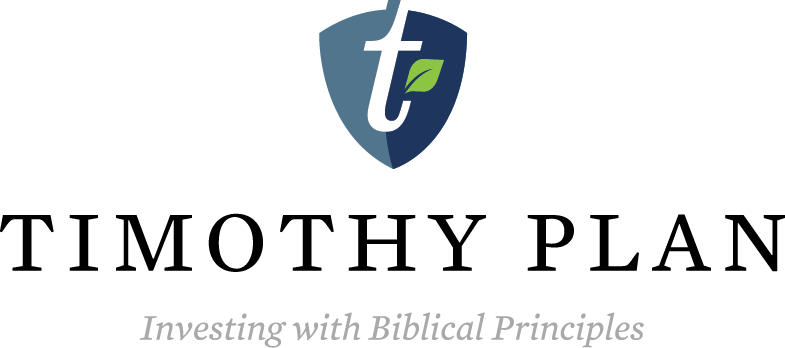International Fund 2Q20
September 15, 2020
Recent Posts
- A Businessman Who Really Did Give it All Over to GodSeptember 28, 2022
- A 'Screwtape' Approach to Keeping Christians from Biblically Responsible InvestingSeptember 21, 2022
- Both Inflation and Inaction Are UnbiblicalSeptember 14, 2022
- Misunderstood in the NeighborhoodAugust 18, 2022
- Billy Graham was the inspiration for the new BiblegraphAugust 9, 2022
- A Businessman Who Really Did Give it All Over to God
Categories
Instagram

Investing involves risk, including the potential loss of principal.
Before investing, carefully consider the fund’s investment objectives, risks, charges, and expenses of the investment company. This and other important information can be found in the fund’s prospectus. To obtain a copy, visit TIMOTHYPLAN.COM or call 800.846.7526. Read each prospectus carefully before investing.
Because the Timothy Plan Funds do not invest in excluded securities, the Funds may be riskier than other funds that invest in a broader array of securities. There are risks when a fund limits its investments to particular sized companies, and all companies are subject to market risk. The Fund recently experienced significant negative short-term performance due to market volatility associated with the Covid-19 pandemic.
MUTUAL FUND INVESTOR
To read more about our mutual funds, please click this link to access fund information, including the prospectus, fact sheets, performance, and holdings for each fund.A prospectus is available from the Fund or your financial professional that contains more complete, important information. Please read it carefully before investing. Mutual Funds distributed by Timothy Partners, Ltd. Member FINRA.
HEADQUARTERS: 1055 Maitland Center Commons, Maitland, FL
(800) 846-7526 | Send an email | View our mapMUTUAL FUND SHAREHOLDER SERVICES: c/o Ultimus Fund Solutions, Post Office Box 541150, Omaha, NE 68154-1150
(800) 662-0201 | Account AccessETF INVESTOR
To read more about our ETFs, please click this link to access fund information, including fact sheets, performance and holdings for each fund. A prospectus is available from the Fund or your financial professional that contains more complete, important information. Please read it carefully before investing. ETFs distributed by Foreside Fund Services, LLC, Member FINRA. Timothy Partners, Ltd. is not affiliated with Foreside Fund Services, LLC.
ETF SHAREHOLDER SERVICES: Contact your financial advisor for information regarding your account.







Market Backdrop
International equity investors were rewarded with a sharp rebound in stock prices during Q2 2020 as they looked beyond historically negative economic data in anticipation of a partial reopening of the global economy and progress on a vaccine. Improving sentiment led by FOMO (Fear of Missing Out) and less defensive positioning overshadowed skepticism about a V-shaped recovery and warnings from public health experts about a second wave of infections. Markets also shrugged off U.S./China tensions including the Senate passage of the Holding Foreign Companies Accountable Act, which requires foreign companies to provide financial transparency. Chinese stocks who fail to comply could be delisted from major U.S. exchanges. By quarter-end, returns moderated due to overbought conditions and concern about new virus cases threatening the economic recovery.
To promote economic growth, developed market policy makers made further stimulus announcements which in total, dwarf the level of support provided during the 2008 Global Financial Crisis. In late May, the European Commission unveiled a €750B pandemic recovery plan, which was followed by bond buying programs by the ECB and the Bank of England. Of greatest surprise, however, was the kiss and make up between Germany and France for a pandemic rescue deal, a sign of a coordinated effort to lead the EU out of the biggest recession in 63 years. Angela Merkel led the way with the announcement of a €130B package to promote growth on more than 50 initiatives. Merkel also buried her grievances with French premier Emmanuel Macron to produce €500bn of grants (known as the Recovery Fund) for hard-pressed businesses across the EU, despite fierce opposition from countries known as the frugal four”– the Netherlands, Sweden, Denmark and Austria. A final compromise should be resolved by the end of July and likely mark an inflection point for Europe as investors take advantage of the improving outlook. The European Central Bank also stirred the pot with a generous increase in lending to sovereign nations and the banking sector, joining the U.S. Federal Reserve, the Bank of Japan and the Bank of England in making sure the cost of borrowing remains at all-time lows for years to come. China also continued stimulus measures with a variety of rate cuts, and increased lending facilities to commercial banks. They also asked banks to cap interest rates on loans to selected firms.
Performance and Attribution
The Timothy Plan International Fund bounced back strongly in absolute terms and had one of its best relative return quarters in the history of the Fund versus the benchmark index. Allocation was fairly neutral while stock selection provided all of the alpha. Selection was positive in 9 out of 10 sectors represented in the Fund. Stock selection was led by great selection in the Industrials and Consumer Discretionary sectors followed by the Financials, IT, and Communications Services sectors. Individual stocks leading the way for the Fund in the quarter included Techtronic Industries (Hong Kong-Industrials), ASML Holdings (Netherlands-IT), Deutsche Boerse (Germany-Financials). From a country standpoint, the Fund had its best selection in the quarter in the UK, China, and Hong Kong.
Outlook
The market dislocation during the first quarter has given our team the opportunity to evaluate attractive companies in various sectors where long-term structural growth stories with solid fundamentals now have compelling valuations. Although we did not expect the market to bounce back as quickly as it did, our focus on high quality, structural growth stories was quite fruitful for the quarter as the Fund outperformed handily. We expect a choppier 2nd half on a plethora of unknowns but expect investors to more and more look through to 2021as the year progresses. The European Recovery Plan is a game changer for continued integration and debt unification there while renewed USD weakness is a tailwind to international stock returns.